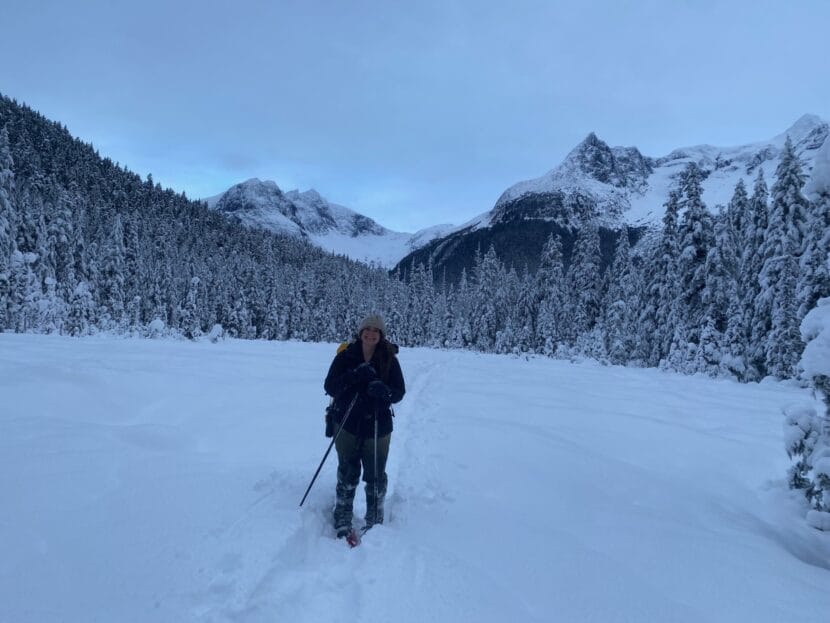
For many of Southeast Alaska’s rural communities, forests and oceans are like a pantry, stocked with foods like fish, berries and shellfish that support nutrition and cultural well-being.
All those foods, and the people that eat them, are intimately connected to each other. Marie Gutgesell, a post-doc with the Pacific Northwest Research Station, is recording those connections using food webs for a new project with the U.S. Forest Service.
She joined KTOO’s Anna Canny to talk about it.
Audio PlayerThis interview has been edited for length and clarity.
Anna Canny: So, I definitely remember drawing a food web in like elementary school. Maybe that’s a universal experience. But it’s been awhile, so maybe you could start by telling me what a food web is?
Marie Gutgesell: So food webs in a really general context are just the interactions that species have with each other in sort of like a predator-prey sense. So it really describes, you know, who’s eating who on the landscape and how much are they eating of each other.
Anna Canny: Okay. I think a lot of people here are probably at least a bit familiar with the food webs that exist here, given how many people are doing subsistence harvesting or even just sport hunting and fishing.
Marie Gutgesell: Yeah, absolutely. In Alaska, and I’m specifically focused in Southeast Alaska, wild foods are an integral part of communities’ ways of life. And those who are actually participating in wild food foraging, obviously know the importance of these forests in providing these wild foods. I mean, in communities across Southeast, they’re harvesting over like 150 different types of species. So it’s a pretty amazing diversity of resources. But I don’t think it’s always recognized from that sort of higher management level, and so how can we re-envision how we’re thinking about public land management to promote the productivity and availability of these wild foods?
Anna Canny: So it sounds like the food web approach has kind of been left out of traditional forest management?
Marie Gutgesell: I think it’s historically not very common at all. We tend to often focus management from sort of single species perspectives. We are starting to see shifts — like one example I can think of is when I mean, these forests are salmon forests, right? And so we’re starting to, you know, develop sort of food web models and food web thinking about restoration processes or sort of different areas for management to maintain sort of food web linkages that support the salmon.
Anna Canny: You’re basically saying that managing a forest for salmon is a good start. But it’s not good enough. We’ve got to consider the whole food web that salmon is a part of. So how do you go about constructing that web?
Marie Gutgesell: Really good question. So, there’s a really impressive, comprehensive dataset that the Alaska Department of Fish and Game has, since the 1980s, gathered data on subsistence harvest from communities across Southeast and also the rest of Alaska. So through that data, we can start to, from at least from the human perspective, sort of, like understand what are all of those linkages? And that’s sort of our first step is thinking how do humans fit into this? What are they eating? And how much are they eating? But then, you know, the sort of next step, which is definitely a more challenging endeavor, is then trying to understand what are the interactions between those species that they’re foraging on? So, you know, bears interact with salmon and berries, which might influence their accessibility to humans and things like that.
Anna Canny: Obviously the environment is not constant. I can’t just draw my food web on a worksheet and have it stay that way, like I did in school. And so your research also considers how the food web can be rewired. Can you explain what that looks like?
Marie Gutgesell: So rewiring is just the changing of those interactions within a food web. So that can be through what we call topological rewiring. So essentially, you know, if a new species — like an invasive species — enters an ecosystem, they’re creating new feeding links within that food web. And then there’s something called an interaction strength rewiring, so that’s changing the magnitude of energy flow between different species. So for example, if the availability of a particular resource is benefited by climate change or due to other reasons we’re seeing an increase in that resource, a consumer might shift their foraging to now more rely on that particular resource.
Anna Canny: Oh so say you’re losing some Salmonberries or some Chinook salmon, but you’re getting more blueberries and pinks. And we want to know more precisely where those kinds of shifts are happening. I don’t know if that’s a good example but…
Marie Gutgesell: Yeah, but, exactly exactly. And it’s important for us to think about because that strength of that interaction, that amount of energy flow, is really important for sort of understanding the stability of that system. But it’s a really, you know, sort of large area of research right now trying to understand how are these wild foods going to change under future climate conditions? Are they going to become more available, less available? More productive, less productive? You know, are they going to be available at different times of the season? But I think it’s exciting to see this start to develop into into a really big research program. So excited to see where it goes.